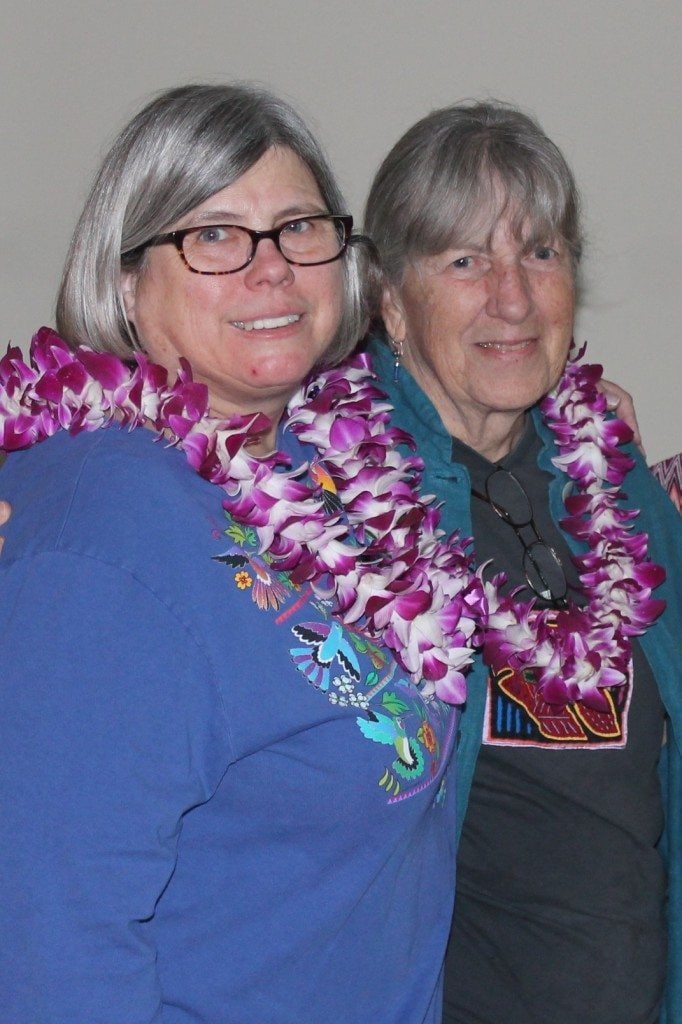WILD (ly successful) in Alameda
By Ilana DeBare
Least Terns. Harbor Seals. Western Bluebirds…. Alameda’s rich variety of wildlife had their day in the sun – or, um, drizzle — on Saturday as part of Golden Gate Bird Alliance’s Wild! in Alameda symposium and viewing stations.
About 100 people including Alameda Mayor Trish Spencer filled the Alameda Main Library for the two-hour symposium and slide show on eight species that make the island their home for all or part of the year.
Snowy and Great Egrets
GGBA Executive Director Cindy Margulis described the nesting colony of egrets on Bay Farm Island. Discovered in 2007, the nests used to extend over five or six trees but after several trees were thoughtlessly trimmed, the colony contracted to one pine tree. It has about 29 nests — 12 percent of all Great Egret nests in the East and South Bay.
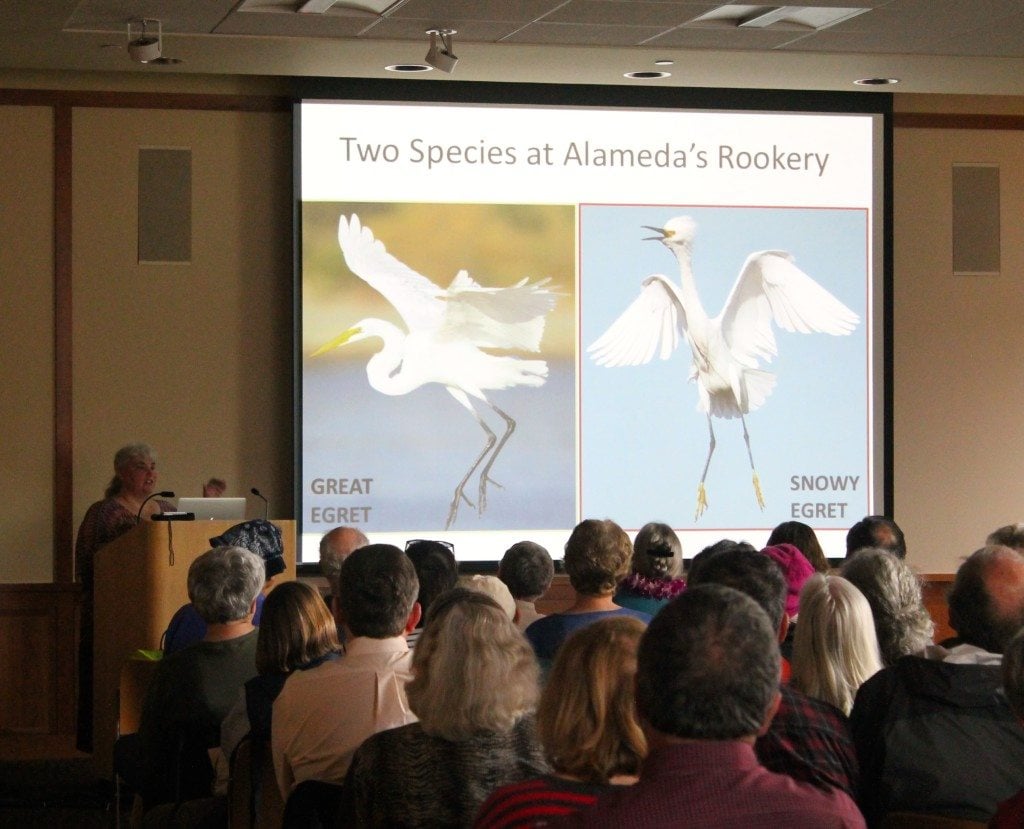
Ospreys
Richard Bangert, publisher of the Alameda Point Environmental Report, recounted the soap opera-like saga of Ospreys trying to nest at Alameda Point. Over the past few years, they’ve tried nesting in inhospitable places (masts of ships, a light pole directly over a motorcycle class area). One year, breeding was distracted by the arrival of a second, rival female. Another year, Common Ravens nesting nearby chased the Ospreys off.
“There was a certain self-confidence about those ravens,” Bangert said. “It was one of the most in-your-face bird actions. It actually picked up the Ospreys’ nesting materials and took it over to their (ravens’) nest.”
Perhaps 2016 will be more auspicious: The Osprey pair has chosen a more secure spot and may be sitting on an egg.
The Alameda Ospreys are part of a general renaissance of this majestic species. Once threatened with extinction due to DDT, Ospreys started nesting along San Francisco Bay for the first time in documented history in 1990. Now there are around 30 nests along the Bay. “The hypothesis is that Bay water is cleaner than it used to be, and it’s easier for them to see fish in the water,” Bangert said.
Harbor Seals
Mark Klein, who used to work with the Marine Mammal Research Center, described the harbor seal population that hauls out on a dock at Seaplane Lagoon. When that dock was threatened because of development, seal lovers spoke out and won installation of a new floating dock for the seals, which is scheduled to be installed in about six weeks. December 2015 was a new record for the seal population there, with 38 hauled out at one time.
“They haul out for several reasons,” Klein said. “To warm up since they don’t have a lot of blubber like elephant seals, to give birth and nurse their young, and to molt and throw off their old skin and grow a new one.”
California Least Terns
Perhaps Alameda’s best-known bird is the California Least Tern — a tiny, endangered species that has been nesting on the tarmac of the former Alamed Naval Air Station for at least 40 years. Susan Euing, the U.S. Fish & Wildlife Service biologist who manages the tern colony, described its breeding cycle: They arrive in mid- to late-April from points as far south as Ecuador. Early May sees the first wave of nests. By late May or early June, chicks have hatched. Within three weeks they have started flying, and within another three weeks they are heading south again.
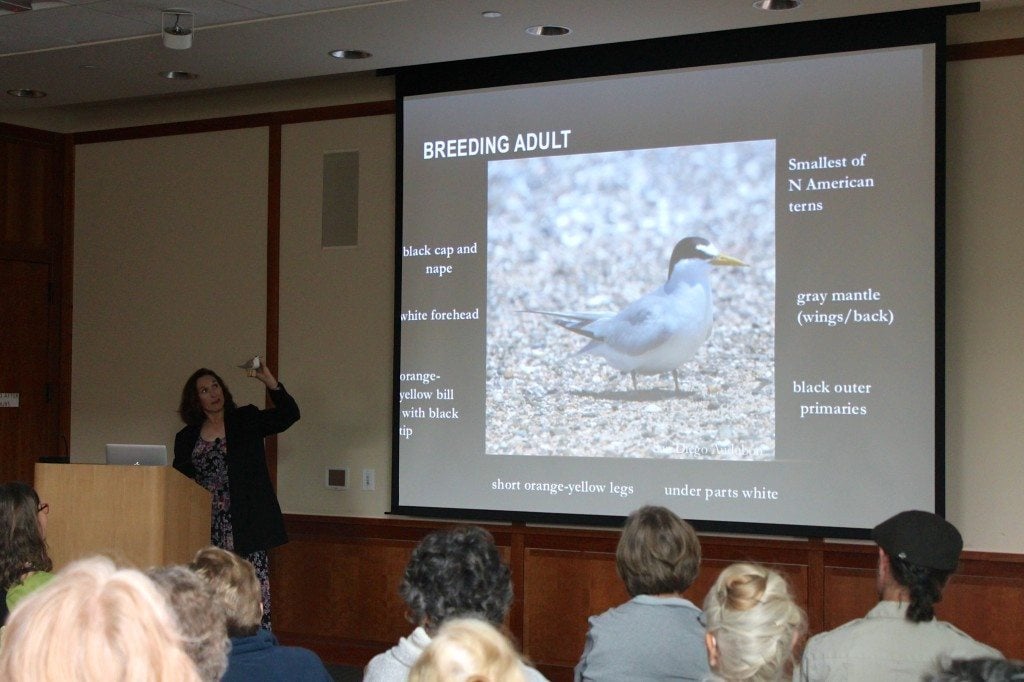
Why do they make airport runways their home? “They like big open beaches,” Euing said. “But there’s a lot of competition since people also like big open beaches for their dogs or for condos.”
GGBA volunteers have helped USFW&S monitor and prepare the terns’ nest site for years. These days, the Alameda Point area is home not just to Least Terns but to a breeding colony of Caspian Terns and to Burrowing Owls, stilts, avocets, and Barn Swallows.
Western Snowy Plovers
Diane Bennett, a citizen-scientist and GGBA board member, described the amazing discovery of a wintering Snowy Plover population on Crown Memorial State Beach several years ago. Decades-old notes by conservation pioneer Elsie Roemer had mentioned plovers, but no one had seen any there in recent memory. When Bennett and some others did a Point Blue shorebird survey along Crown Beach in 2013, they decided to make a special search for plovers — and found some!
Since then, GGBA and other plover lovers convinced the East Bay Regional Park District to install symbolic protective fencing during the winter, when the plovers roost on the beach. And the numbers spotted there have grown — from a top count of 8 at one time in 2013-14, to 17 in 2014-15, to 31 this past winter. Having a safe winter home to feed, rest, and store energy for the rigors of breeding season may prove key to the recovery of this threatened species.
“We’ve documented that they are using the fenced-off area,” Bennett said. “We feel we have some contented Western Snowy Plovers. We know we have some happy citizens.”
Western Bluebirds
Michael Charnofksy, a naturalist with the East bay Regional Park District, described the growth of a Western Bluebird population in Alameda’s open areas. From just one documented nest in 2002, the numbers have grown to eight in 2011, 25 in 2013, and 15 in 2014.
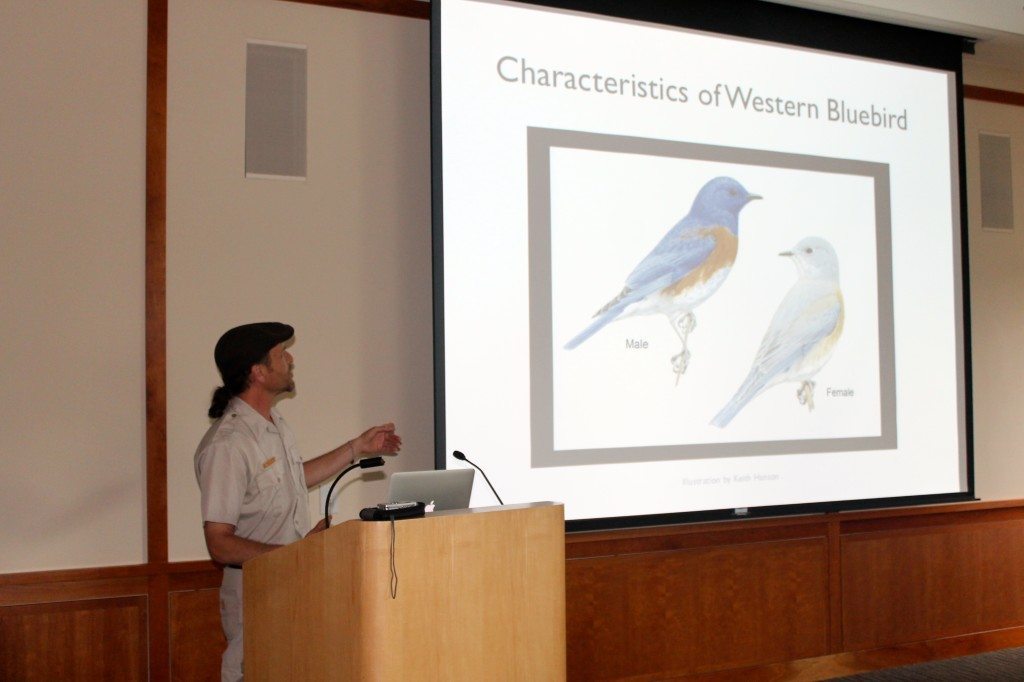
While not listed as endangered, Western Bluebirds face a similar challenge to Least Terns — finding suitable nest sites. They are cavity nesters that seek out old woodpecker holes in dead trees, but humans tend to view dead trees as eyesores that need to be removed. “Plus they compete with starlings and House Finches for cavities,” Charnofsky said.
What’s changed? “People have been putting up nest boxes, and they seem to be increasing,” he said.
Peregrine Falcons
Shirley Doell, a citizen-scientist with the Santa Cruz Predatory Bird Research Group, described Peregrine Falcon pairs that have been nesting on the Fruitvale Bridge every year since 2009. Thanks to banding work, the “biographies” of many of these birds are known to us. For instance, in 2010 the male falcon was one that had been hatched in a nest on San Jose City Hall! This year’s falcon pair is unbanded though… so for now, at least, they remain mystery birds.
California Brown Pelicans
Brown Pelicans have been documented roosting on Alameda’s Breakwater Island since the mid-1980s, according to Leora Feeney, chair of GGBA’s Friends of the Alameda Wildlife Reserve committee. Roosting is essential for pelicans since they have “wettable” plumage that can be saturated to the skin, and they are vulnerable to hypothermia. But the Alameda roost never sparked any interest from scientists studying the overall population, even as Brown Pelican numbers overall have dropped due to three recent years of breeding failures.
That changed last year — a happy side-effect of a tragic event. In May 2015, an oil spill near the Channel Islands in Southern California dumped 100,000 gallons of oil into the coastal waters, killing hundreds of birds and marine mammals. Scientists wanted to study the after-effects of the spill, and so put tiny solar-powered satellite transmitter on the backs of a number of both rescued and un-oiled pelicans before releasing them.
One bird — named “Z-31” — was cleaned and released in late June, and then found at the Alameda roost in late August! Satellite tracking showed it made numerous forays back and forth from Alameda to fish. “Our bird is using this as a roost site, and foraging on the coast,” Feeney said. “Guess what! We are now on the list of important roost sites for California. Z-31… I love you!”
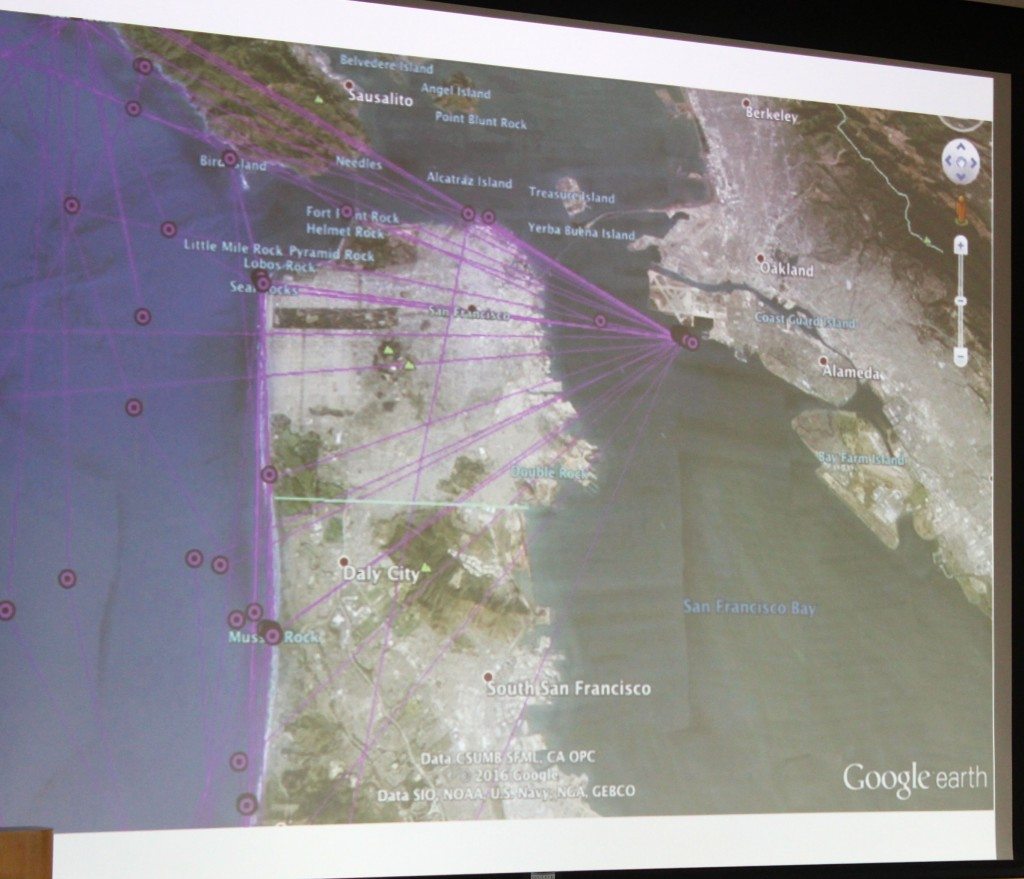
By the way, how many Brown Pelicans have been sighted roosting on that half-mile-long breakwater? Five thousand or more! One sighting in 2006 put the number at a whopping 8,000.
Beyond the Symposium
In the afternoon, GGBA and its partners sponsored viewing stations around the island of Alameda so people could get real-life glimpses of the birds and animals they’d learned about that morning.
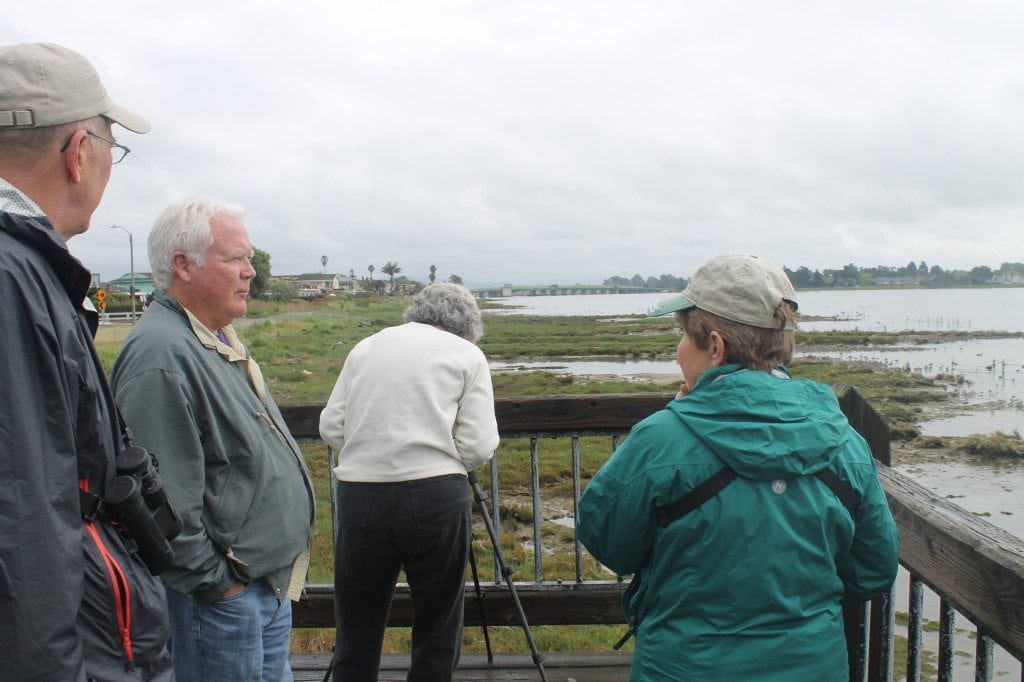
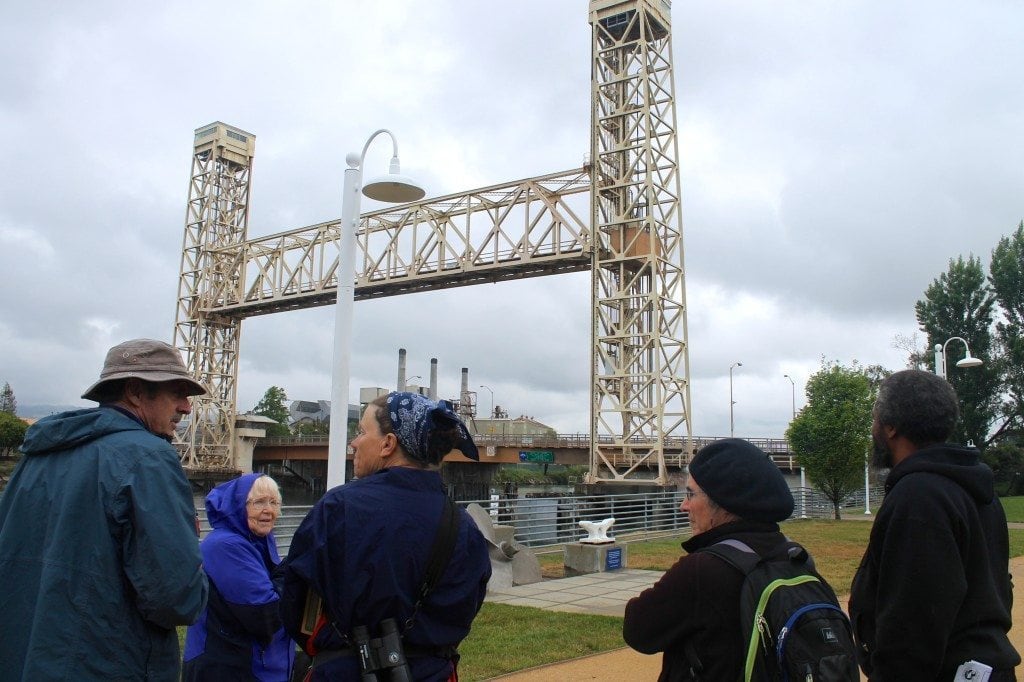
The Wild! in Alameda photography exhibit at the Alameda Main Library will remain up through the end of May. All are welcome to view it whenever the library is open: Ask the front desk to open the room.
Want to get involved in helping Alameda wildlife? There are many opportunities through Friends of the Alameda Wildlife Reserve: See our web site for details.
The symposium was WILD-ly successful! Many thanks to everyone who helped contributed to the symposium, the viewing stations, and the photography show: Organizers Leora Feeney and Linda Carloni; the Alameda Free Library; East Bay Regional Park District; U.S. Fish & Wildlife Service, Alameda Point Partners; Friends of the Alameda Wildlife Reserve volunteers; and all the talented photographers who contributed their work.
